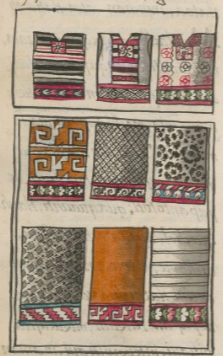xicalcoliuhqui (FCbk8f30v)
This iconographic example, featuring a piece of cloth or a skirt with a stepped fret design (xicalcoliuhqui) is included in this digital collection for the purpose of making potential comparisons with related hieroglyphs. The term selected for this example comes from the text that appears on the same page. This example shows a large rectangle that is apparently a skirt (cueitl). It has two rows across the top with the rectangular spirals that are also called stepped frets (xicalcoliuhqui). These are orange on a white background, with orange and white stripes separating these two rows. Below that is a lower border of three-petaled flowers on their sides, with white petals and green stems and leaves. The flowers are on a black background. A thin red stripe appears above and below the row of flowers. On this same page, the large blank orange cloth has another stepped fret design on its lower border, too.
Stephanie Wood
The most common stepped fret designs in this collection are found in paintings of water glyphs or elements of glyphs. But see also the war shield with this design that comes from the Codex Mendoza. For more examples, see the Advanced Search, Shape category, “spiral as rectangular.”
Stephanie Wood
xicalcoliuhqui cueitl
Stephanie Wood
1577
Jeff Haskett-Wood
espirales, rectángulos, textiles, faldas, diseños, ropa, mujer, mujeres
xicalcoliuhqui, a stepped fret design, https://nahuatl.wired-humanities.org/content/xicalcoliuhqui
el diseño espiral rectangular
Stephanie Wood
Available at Digital Florentine Codex/Códice Florentino Digital, edited by Kim N. Richter and Alicia Maria Houtrouw, "Book 8: Kings and Lords", fol. 30v, Getty Research Institute, 2023. https://florentinecodex.getty.edu/en/book/8/folio/30v/images/35690bb6-0e... Accessed 11 August 2025.
Images of the digitized Florentine Codex are made available under the following Creative Commons license: CC BY-NC-ND (Attribution-NonCommercial-NoDerivs 4.0 International). For print-publication quality photos, please contact the Biblioteca Medicea Laurenziana ([email protected]). The Library of Congress has also published this manuscript, using the images of the World Digital Library copy. “The Library of Congress is unaware of any copyright or other restrictions in the World Digital Library Collection. Absent any such restrictions, these materials are free to use and reuse.”






